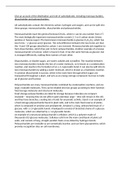Give an account of the distribution and role of carbohydrates, including monosaccharides,
disaccharides and polysaccharides.
All carbohydrates contain the elements carbon, hydrogen and oxygen, and can be split into
three groups: monosaccharides, disaccharides and polysaccharides.
Monosaccharides have the general formula (CH2O)n, where n can be any number from 3-7.
The most biologically important monosaccharides contain 3, 5 or 6 carbon atoms (triose,
pentose or hexose sugar). The best-known monosaccharide is glucose (C 6H12O6), which has
two forms – -glucose and -glucose. The only difference between the two forms are that
the -H and -OH groups attached to carbon 1 are reversed. Monosaccharides join together to
form disaccharides, which then join to form polysaccharides. Another example of a hexose
monosaccharide is fructose, which is found in fruit. It has the same formula as glucose, but
is arranged differently, making them isomers of each other.
Disaccharides, or double sugars, are sweet, soluble and crystalline. The reaction between
two monosaccharides includes the loss of a water molecule, so is known as a condensation
reaction, and results in the formation of an -1,4 glycosidic bond. It can also be split into its
two monosaccharides by adding a water molecule, which is known as a hydrolysis reaction.
A common disaccharide is sucrose, which is the main form through which sugars are
transported throughout a plant, and acts as an energy storage compound. Sucrose is made
up of glucose and fructose.
Polysaccharides are many monosaccharides combined by condensation reactions, and are
large, insoluble molecules. They can be divided into two groups according to their function:
food storage molecules and structural molecules.
Food storage polysaccharides are ideal for storage because molecules are compact;
insoluble – meaning they do not affect water potential; large – they will remain in the cell;
and they have branches, creating lots of ends for enzymatic activity. Starch is an example of
a food storage polysaccharide found in plant cells, and is the main food reserve of plants,
which is composed of amylose and amylopectin. Amylose is a long, unbranched chain of -
glucose, with -1,4 glycosidic bonds. Amylopectin consists of branched chains of -glucose
molecules, which are attached by -1,6 glycosidic bonds.
An example of a structural polysaccharide is cellulose, which is a polymer made of
thousands of -glucose molecules. Cellulose cells form the main constituent of plant cell
walls, and consists of long, straight parallel chains cross-linked by hydrogen bonds.
Polysaccharides are insoluble so are osmotically inactive, and can form glycoproteins, which
provides recognition sites on cell membranes.




